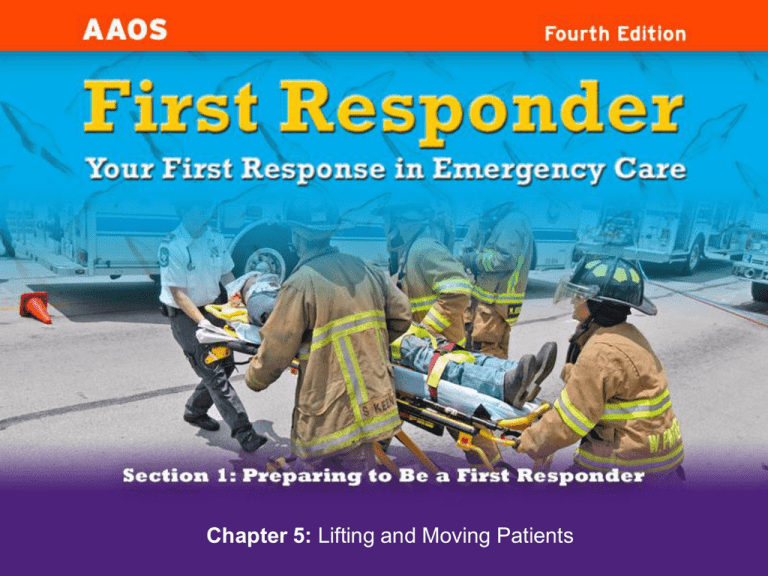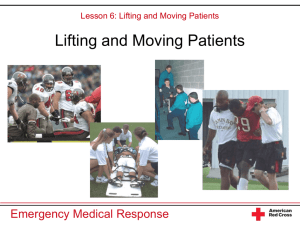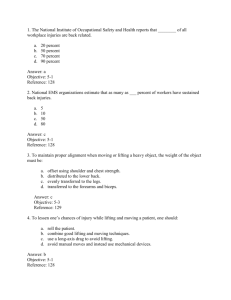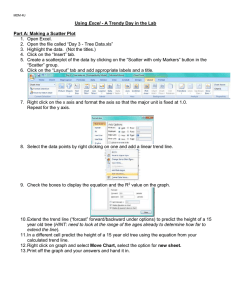Moving patients
advertisement

Chapter 5: Lifting and Moving Patients Cognitive Objectives 1-5.1 Define body mechanics. 1-5.2 Discuss the guidelines and safety precautions that need to be followed when lifting a patient. 1-5.3 Describe the indications for an emergency move. (1 of 2) Cognitive Objectives 1-5.4 Describe the indications for assisting in nonemergency moves. 1-5.5 Discuss the various devices associated with moving a patient in the out-of-hospital arena. (2 of 2) Affective Objectives 1-5.6 Explain the rationale for properly lifting and moving patients. 1-5.7 Explain the rationale for an emergency move. Psychomotor Objectives 1-5.8 Demonstrate an emergency move. 1-5.9 Demonstrate a non-emergency move. 1-5.10 Demonstrate the use of equipment utilized to move patients in the out-ofhospital arena. Knowledge and Attitude Objectives 1. Describe the general guidelines for moving patients. 2. Understand the purpose and indications for use of the recovery position. 3. Describe the components of good body mechanics. (1 of 6) Knowledge and Attitude Objectives 4. Describe the steps needed to perform the following emergency patient drags: • Clothes drag • Blanket drag • Arm-to-arm drag • Fire fighter drag • Cardiac arrest patient drag • Emergency drag from a vehicle (2 of 6) Knowledge and Attitude Objectives 5. Describe the steps needed to perform the following carries for nonambulatory patients: • Two-person extremity carry • Two-person seat carry • Cradle-in-arms carry • Two-person chair carry • Pack-strap carry • Direct ground lift • Transfer from a bed to a stretcher (3 of 6) Knowledge and Attitude Objectives 6. Describe the steps needed to perform the following walking assists for ambulatory patients: • One-person assist • Two-person assist (4 of 6) Knowledge and Attitude Objectives 7. Identify and describe the purpose of the following pieces of equipment: • Wheeled ambulance stretcher • Portable stretcher • Stair chair • Long backboard • Short backboard • Scoop stretcher (5 of 6) Knowledge and Attitude Objectives 8. Describe the steps in each of the following procedures for patients with suspected spinal injuries: • Applying a cervical collar • Log rolling • Moving patients using long backboards • Straddle sliding • Assisting with short backboard devices • Straddle lifting • Strapping • Immobilizing the patient’s head (6 of 6) Skill Objectives 1. Place a patient in the recovery position. 2. Lift and move patients using good body mechanics. (1 of 6) Skill Objectives 3. Perform the following emergency patient drags: • Clothes drag • Blanket drag • Arm-to-arm drag • Fire fighter drag • Cardiac arrest patient drag • Emergency drag from a vehicle (2 of 6) Skill Objectives 4. Perform the following patient carries: • Two-person extremity carry • Two-person seat carry • Cradle-in-arms carry • Two-person chair carry • Pack-strap carry • Direct ground lift • Transfer from a bed to a stretcher (3 of 6) Skill Objectives 5. Perform the following walking assists for ambulatory patients: • One-person assist • Two-person assist (4 of 6) Skill Objectives 6. Assist other EMS providers with the following devices: • Wheeled ambulance stretcher • Portable stretcher • Stair chair • Long backboard • Short backboard • Scoop stretcher (5 of 6) Skill Objectives 7. Assist other EMS providers with the following procedures for patients with suspected spinal injuries: • Applying a cervical collar • Log rolling a patient onto a long backboard • Moving a patient using a backboard • Straddle lift • Applying short backboard devices • Strapping techniques • Straddle slide • Head immobilization (6 of 6) General Principles • Do no further harm to the patient. • Move patient only when necessary. • Move patient as little as possible. • Move patient’s body as a unit. • Use proper lifting and moving techniques. • Have one rescuer give commands. Recommendations • Delay movement. • Treat patient before starting the move. • Try not to step over patient. • Explain to patient what is going to be done and how. • Move patient as few times as possible. Recovery Position Unconscious patients who have not suffered trauma should be placed in the recovery position. Body Mechanics • • • • • • Ensure your own safety. Exercise good body mechanics. Use leg muscles when lifting. Get close to patient and keep your back straight. Lift without twisting. Assess the weight of your patient. (1 of 3) Body Mechanics (2 of 3) Body Mechanics • Know your limitations. Call for additional help if needed. • Communicate with all those lifting. • Practice lifts and moves. (3 of 3) Emergency Movement • Move patients immediately when: – Danger of fire, explosion, or structural collapse exists. – Hazardous materials are present. – Accident scene cannot be protected. – Access to other seriously injured patients is needed. – CPR must be performed. Emergency Drags • Clothes drag – Cardiac patients and clothes drag • Blanket drag • Arm-to-arm drag • Fire fighter drag • Emergency drag from a vehicle Clothes Drag for Cardiac Patients Carries for Nonambulatory Patients • • • • • • • Two-person extremity carry Two-person seat carry Cradle-in-arms carry Two-person chair carry Pack-strap carry Direct ground lift Draw-sheet method Walking Assists for Ambulatory Patients • One-person walking assist • Two-person walking assist One-Person Walking Assist Equipment • EMS services commonly use various types of patient-moving equipment. • Be familiar with the equipment used by your service. Stretchers Wheeled ambulance stretcher Portable stretcher Stair Chair Backboards Long backboard Short backboard device Scoop Stretcher Suspected Head or Spine Injury • Move patient as a unit. • Transport patient face up. • Keep patient’s head and neck in a neutral position. • Be sure all rescuers know what is being done. • Be sure only one rescuer is giving commands. Application of Cervical Collars • Stabilize head and neck. • Insert back part of collar. • Apply front part of collar. • Secure collar together. Log Rolling • Primary technique to move patient onto a long backboard • Move patient as a unit. • Keep the patient’s head in a neutral position at all times. Alternatives to Log Roll • Straddle lift – Can be used to place a patient on a backboard if there is not enough room to log roll • Straddle slide – The patient, rather than the backboard, is moved. Straddle Slide Strapping Techniques • There are many ways to strap a patient. • Always immobilize the body before the head. • Learn the method used by your EMS system. Head Immobilization • Blanket roll • Commercial devices • Head stabilization must be maintained throughout entire procedure.







